MERCEDES-BENZ S430 2002 W220 Owner's Manual
Manufacturer: MERCEDES-BENZ, Model Year: 2002, Model line: S430, Model: MERCEDES-BENZ S430 2002 W220Pages: 430, PDF Size: 20.81 MB
Page 381 of 430
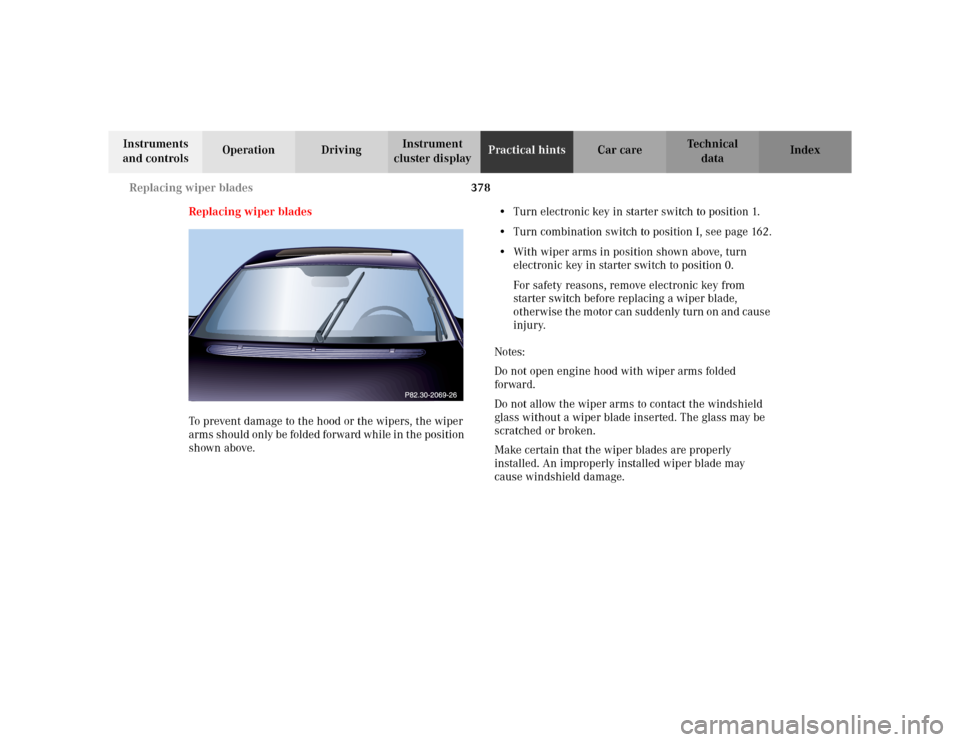
378 Replacing wiper blades
Te ch n i c a l
data Instruments
and controlsOperation DrivingInstrument
cluster displayPractical hintsCar care Index
Replacing wiper blades
To prevent damage to the hood or the wipers, the wiper
arms should only be folded forward while in the position
shown above.•Turn electronic key in starter switch to position 1.
•Turn combination switch to position I, see page 162.
•With wiper arms in position shown above, turn
electronic key in starter switch to position 0.
For safety reasons, remove electronic key from
starter switch before replacing a wiper blade,
otherwise the motor can suddenly turn on and cause
injury.
Notes:
Do not open engine hood with wiper arms folded
forward.
Do not allow the wiper arms to contact the windshield
glass without a wiper blade inserted. The glass may be
scratched or broken.
Make certain that the wiper blades are properly
installed. An improperly installed wiper blade may
cause windshield damage.
Page 382 of 430
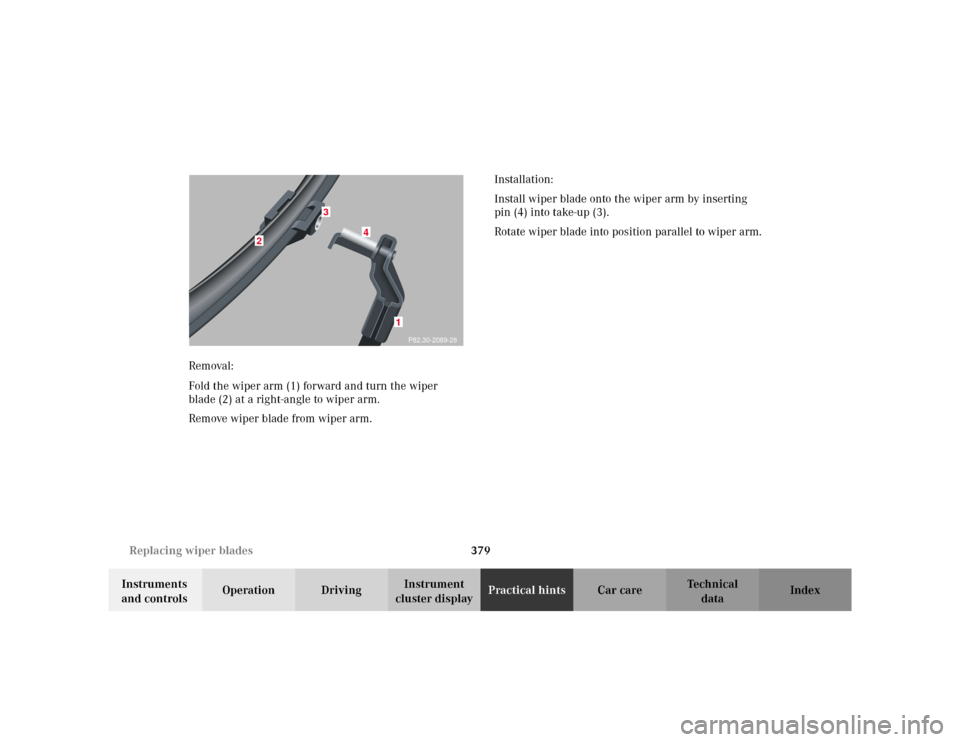
379 Replacing wiper blades
Te ch n i c a l
data Instruments
and controlsOperation DrivingInstrument
cluster displayPractical hintsCar care Index Removal:
Fold the wiper arm (1) forward and turn the wiper
blade (2) at a right-angle to wiper arm.
Remove wiper blade from wiper arm.Installation:
Install wiper blade onto the wiper arm by inserting
pin (4) into take-up (3).
Rotate wiper blade into position parallel to wiper arm.
P82.30-2089-26
4
1
2
3
Page 383 of 430
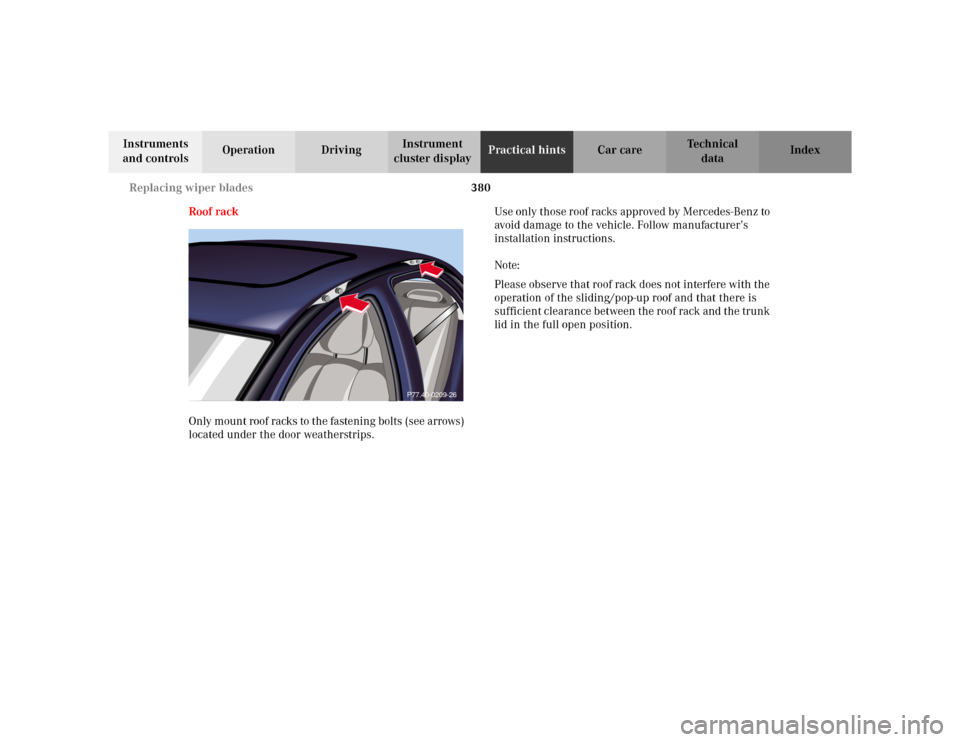
380 Replacing wiper blades
Te ch n i c a l
data Instruments
and controlsOperation DrivingInstrument
cluster displayPractical hintsCar care Index
Roof rack
Only mount roof racks to the fastening bolts (see arrows)
located under the door weatherstrips.Use only those roof racks approved by Mercedes-Benz to
avoid damage to the vehicle. Follow manufacturer’s
installation instructions.
Note:
Please observe that roof rack does not interfere with the
operation of the sliding/pop-up roof and that there is
sufficient clearance between the roof rack and the trunk
lid in the full open position.
P77.40-0209-26
Page 384 of 430
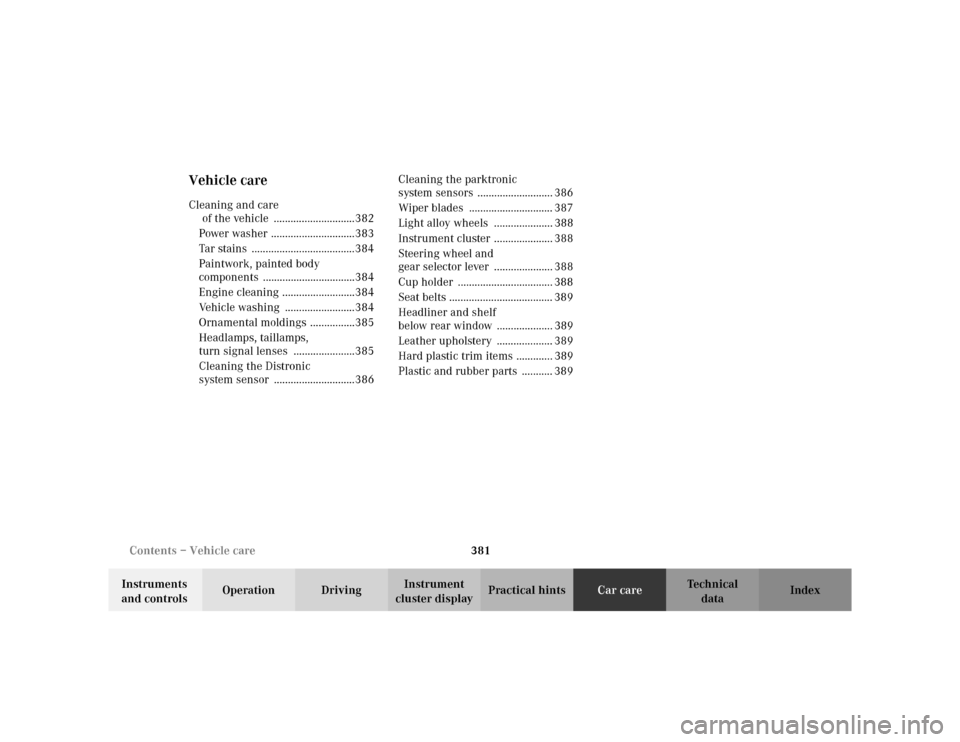
381 Contents – Vehicle care
Te ch n i c a l
data Instruments
and controlsOperation DrivingInstrument
cluster displayPractical hintsCar careIndex
Vehicle careCleaning and care
of the vehicle .............................382
Power washer ..............................383
Tar stains .....................................384
Paintwork, painted body
components .................................384
Engine cleaning ..........................384
Vehicle washing .........................384
Ornamental moldings ................385
Headlamps, taillamps,
turn signal lenses ......................385
Cleaning the Distronic
system sensor .............................386Cleaning the parktronic
system sensors ........................... 386
Wiper blades .............................. 387
Light alloy wheels ..................... 388
Instrument cluster ..................... 388
Steering wheel and
gear selector lever ..................... 388
Cup holder .................................. 388
Seat belts ..................................... 389
Headliner and shelf
below rear window .................... 389
Leather upholstery .................... 389
Hard plastic trim items ............. 389
Plastic and rubber parts ........... 389
Page 385 of 430
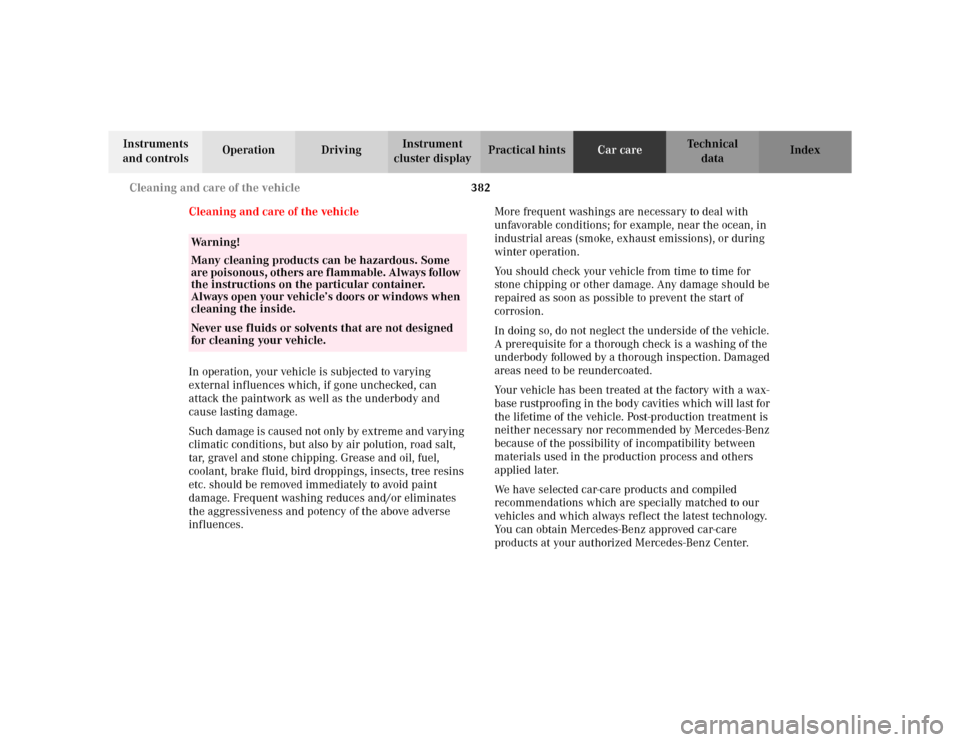
382 Cleaning and care of the vehicle
Te ch n i c a l
data Instruments
and controlsOperation DrivingInstrument
cluster displayPractical hintsCar careIndex
Cleaning and care of the vehicle
In operation, your vehicle is subjected to varying
external influences which, if gone unchecked, can
attack the paintwork as well as the underbody and
cause lasting damage.
Such damage is caused not only by extreme and varying
climatic conditions, but also by air polution, road salt,
tar, gravel and stone chipping. Grease and oil, fuel,
coolant, brake fluid, bird droppings, insects, tree resins
etc. should be removed immediately to avoid paint
damage. Frequent washing reduces and/or eliminates
the aggressiveness and potency of the above adverse
influences.More frequent washings are necessary to deal with
unfavorable conditions; for example, near the ocean, in
industrial areas (smoke, exhaust emissions), or during
winter operation.
You should check your vehicle from time to time for
stone chipping or other damage. Any damage should be
repaired as soon as possible to prevent the start of
corrosion.
In doing so, do not neglect the underside of the vehicle.
A prerequisite for a thorough check is a washing of the
underbody followed by a thorough inspection. Damaged
areas need to be reundercoated.
Your vehicle has been treated at the factory with a wax-
base rustproofing in the body cavities which will last for
the lifetime of the vehicle. Post-production treatment is
neither necessary nor recommended by Mercedes-Benz
because of the possibility of incompatibility between
materials used in the production process and others
applied later.
We have selected car-care products and compiled
recommendations which are specially matched to our
vehicles and which always reflect the latest technology.
You can obtain Mercedes-Benz approved car-care
products at your authorized Mercedes-Benz Center.
Wa r n i n g !
Many cleaning products can be hazardous. Some
are poisonous, others are flammable. Always follow
the instructions on the particular container.
Always open your vehicle’s doors or windows when
cleaning the inside.Never use fluids or solvents that are not designed
for cleaning your vehicle.
Page 386 of 430
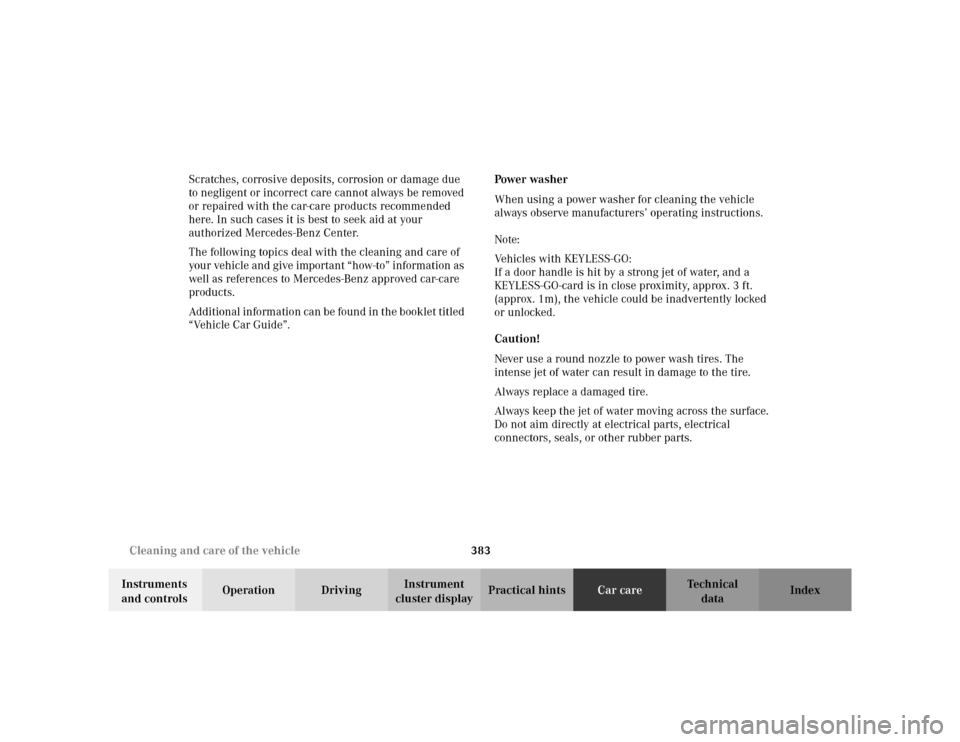
383 Cleaning and care of the vehicle
Te ch n i c a l
data Instruments
and controlsOperation DrivingInstrument
cluster displayPractical hintsCar careIndex Scratches, corrosive deposits, corrosion or damage due
to negligent or incorrect care cannot always be removed
or repaired with the car-care products recommended
here. In such cases it is best to seek aid at your
authorized Mercedes-Benz Center.
The following topics deal with the cleaning and care of
your vehicle and give important “how-to” information as
well as references to Mercedes-Benz approved car-care
products.
Additional information can be found in the booklet titled
“Vehicle Car Guide”.Power washer
When using a power washer for cleaning the vehicle
always observe manufacturers’ operating instructions.
Note:
Vehicles with KEYLESS-GO:
If a door handle is hit by a strong jet of water, and a
KEYLESS-GO-card is in close proximity, approx. 3 ft.
(approx. 1m), the vehicle could be inadvertently locked
or unlocked.
Caution!
Never use a round nozzle to power wash tires. The
intense jet of water can result in damage to the tire.
Always replace a damaged tire.
Always keep the jet of water moving across the surface.
Do not aim directly at electrical parts, electrical
connectors, seals, or other rubber parts.
Page 387 of 430
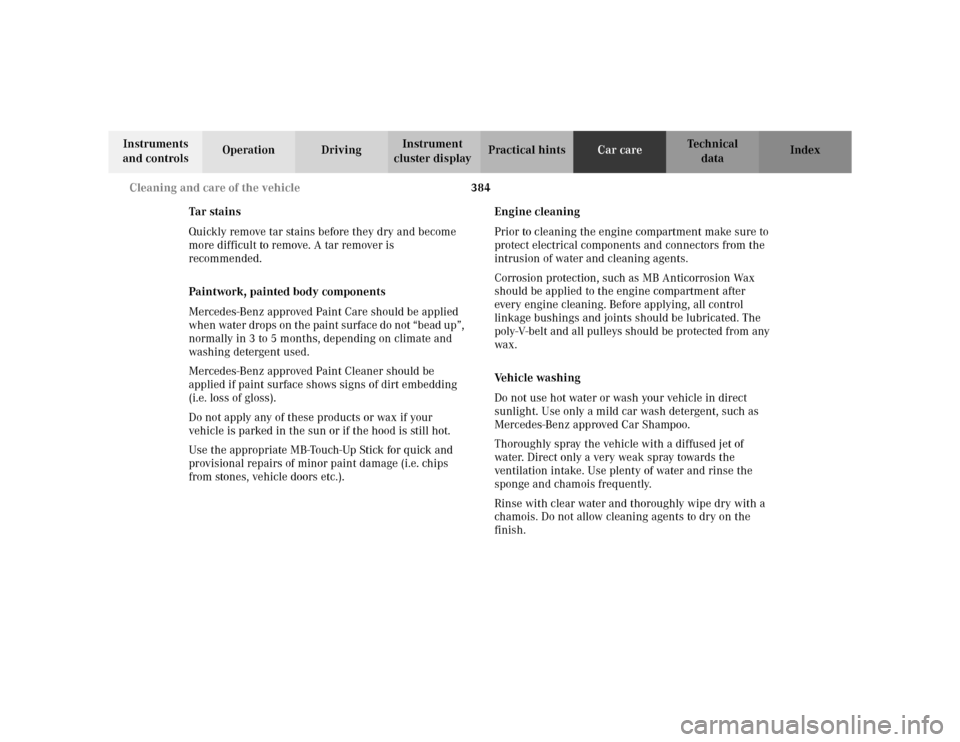
384 Cleaning and care of the vehicle
Te ch n i c a l
data Instruments
and controlsOperation DrivingInstrument
cluster displayPractical hintsCar careIndex
Ta r sta in s
Quickly remove tar stains before they dry and become
more difficult to remove. A tar remover is
recommended.
Paintwork, painted body components
Mercedes-Benz approved Paint Care should be applied
when water drops on the paint surface do not “bead up”,
normally in 3 to 5 months, depending on climate and
washing detergent used.
Mercedes-Benz approved Paint Cleaner should be
applied if paint surface shows signs of dirt embedding
(i.e. loss of gloss).
Do not apply any of these products or wax if your
vehicle is parked in the sun or if the hood is still hot.
Use the appropriate MB-Touch-Up Stick for quick and
provisional repairs of minor paint damage (i.e. chips
from stones, vehicle doors etc.).Engine cleaning
Prior to cleaning the engine compartment make sure to
protect electrical components and connectors from the
intrusion of water and cleaning agents.
Corrosion protection, such as MB Anticorrosion Wax
should be applied to the engine compartment after
every engine cleaning. Before applying, all control
linkage bushings and joints should be lubricated. The
poly-V-belt and all pulleys should be protected from any
wax.
Ve h i c l e w a s h i n g
Do not use hot water or wash your vehicle in direct
sunlight. Use only a mild car wash detergent, such as
Mercedes-Benz approved Car Shampoo.
Thoroughly spray the vehicle with a diffused jet of
water. Direct only a very weak spray towards the
ventilation intake. Use plenty of water and rinse the
sponge and chamois frequently.
Rinse with clear water and thoroughly wipe dry with a
chamois. Do not allow cleaning agents to dry on the
finish.
Page 388 of 430
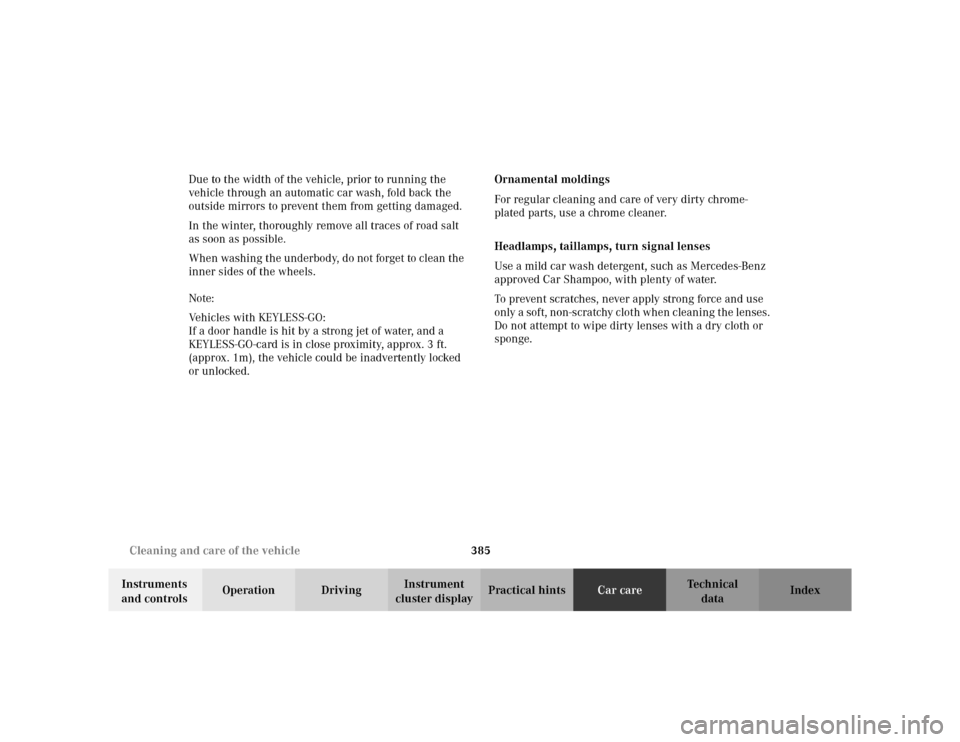
385 Cleaning and care of the vehicle
Te ch n i c a l
data Instruments
and controlsOperation DrivingInstrument
cluster displayPractical hintsCar careIndex Due to the width of the vehicle, prior to running the
vehicle through an automatic car wash, fold back the
outside mirrors to prevent them from getting damaged.
In the winter, thoroughly remove all traces of road salt
as soon as possible.
When washing the underbody, do not forget to clean the
inner sides of the wheels.
Note:
Ve h i c l e s w i t h KE Y L E S S - G O :
If a door handle is hit by a strong jet of water, and a
KEYLESS-GO-card is in close proximity, approx. 3 ft.
(approx. 1m), the vehicle could be inadvertently locked
or unlocked.Ornamental moldings
For regular cleaning and care of very dirty chrome-
plated parts, use a chrome cleaner.
Headlamps, taillamps, turn signal lenses
Use a mild car wash detergent, such as Mercedes-Benz
approved Car Shampoo, with plenty of water.
To prevent scratches, never apply strong force and use
only a soft, non-scratchy cloth when cleaning the lenses.
Do not attempt to wipe dirty lenses with a dry cloth or
sponge.
Page 389 of 430
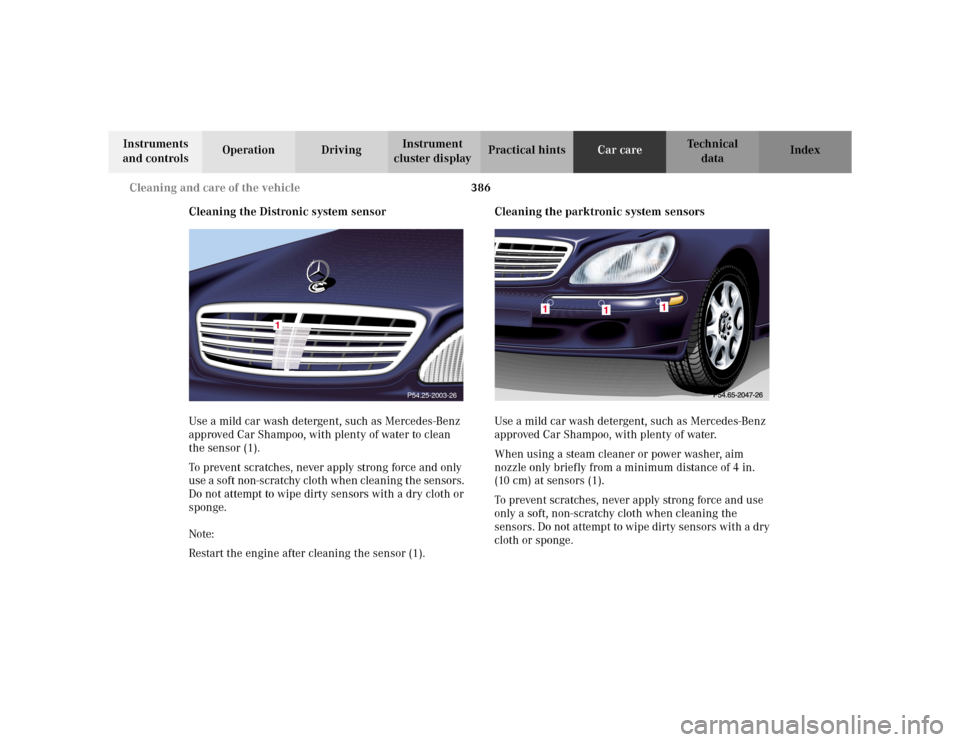
386 Cleaning and care of the vehicle
Te ch n i c a l
data Instruments
and controlsOperation DrivingInstrument
cluster displayPractical hintsCar careIndex
Cleaning the Distronic system sensor
Use a mild car wash detergent, such as Mercedes-Benz
approved Car Shampoo, with plenty of water to clean
the sensor (1).
To prevent scratches, never apply strong force and only
use a soft non-scratchy cloth when cleaning the sensors.
Do not attempt to wipe dirty sensors with a dry cloth or
sponge.
Note:
Restart the engine after cleaning the sensor (1).Cleaning the parktronic system sensors
Use a mild car wash detergent, such as Mercedes-Benz
approved Car Shampoo, with plenty of water.
When using a steam cleaner or power washer, aim
nozzle only briefly from a minimum distance of 4 in.
(10 cm) at sensors (1).
To prevent scratches, never apply strong force and use
only a soft, non-scratchy cloth when cleaning the
sensors. Do not attempt to wipe dirty sensors with a dry
cloth or sponge.
P54.25-2003-26
1
Page 390 of 430
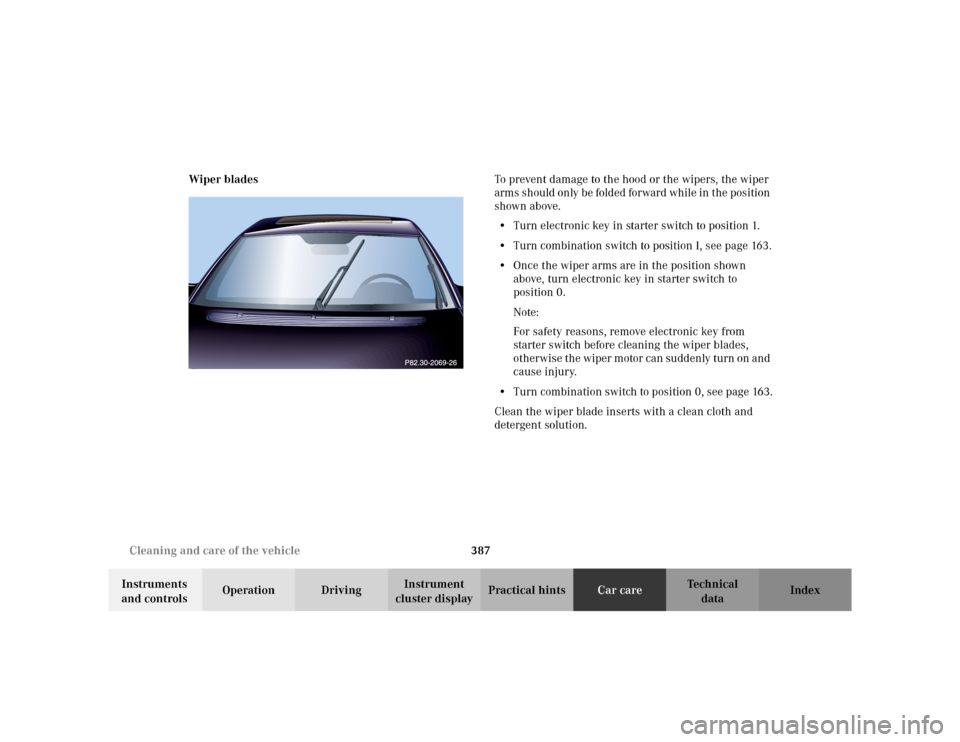
387 Cleaning and care of the vehicle
Te ch n i c a l
data Instruments
and controlsOperation DrivingInstrument
cluster displayPractical hintsCar careIndex Wiper bladesTo prevent damage to the hood or the wipers, the wiper
arms should only be folded forward while in the position
shown above.
•Turn electronic key in starter switch to position 1.
•Turn combination switch to position I, see page 163.
•Once the wiper arms are in the position shown
above, turn electronic key in starter switch to
position 0.
Note:
For safety reasons, remove electronic key from
starter switch before cleaning the wiper blades,
otherwise the wiper motor can suddenly turn on and
cause injury.
•Turn combination switch to position 0, see page 163.
Clean the wiper blade inserts with a clean cloth and
detergent solution.